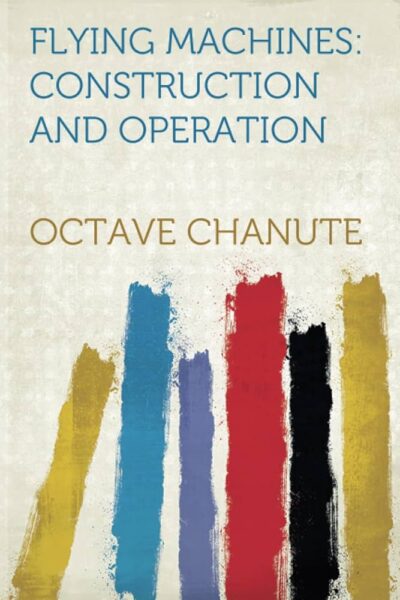32 Results with the "Practical" genre
Adventure Fiction (1164)
Biography (435)
Business & Finance (1)
Children's Literature (124)
Comics (6)
Culture (51)
Drama (123)
Dystopian (29)
Fable (86)
Fantasy (1132)
Fantasy (203)
Fiction (1010)
Finance (1)
Gothic Fiction (12)
Historical Fiction (615)
History (122)
Horror (56)
Lifestyle (36)
Literary (404)
Literary Fiction (207)
Memoir (113)
Mystery (422)
Non-fiction (87)
Novel (549)
Paranormal Fiction (96)
Philosophical (182)
Philosophy (45)
Poetry (249)
Political Fiction (14)
Politics (42)
Psychological (4)
Psychological Thriller (108)
Relationship (6)
Romance Novel (716)
Romantic Melodrama (14)
Satire (91)
Science (46)
Science Fiction (345)
Self-help (68)
Society (65)
Society (2)
Spiritual Growth (1)
story (2)
Thriller (704)
True Crime (56)
view (11)
Women's Fiction (2)
Young Adult (233)
-
 Chapter VIII - Flying Machines Construction And Operation introduces a critical shift in aeronautical design: evolving from simple gliders to functional powered aircraft. This development required careful attention to weight distribution, engine integration, and aerodynamic balance. It wasn’t enough for a machine to lift—it needed to fly with direction, support human weight, and sustain forward motion. Adding a motor and other essential equipment greatly increased the load, demanding a much larger wing…
Chapter VIII - Flying Machines Construction And Operation introduces a critical shift in aeronautical design: evolving from simple gliders to functional powered aircraft. This development required careful attention to weight distribution, engine integration, and aerodynamic balance. It wasn’t enough for a machine to lift—it needed to fly with direction, support human weight, and sustain forward motion. Adding a motor and other essential equipment greatly increased the load, demanding a much larger wing…-
142.7 K • Ongoing
-
-
 Chapter XIX – Flying Machines Construction and Operation dives into the emerging legal complexities brought about by the rise of aviation, a field that, by 1910, had already begun challenging traditional ideas about property, public space, and individual rights. The foundational legal principle discussed here is rooted in ancient common law: landowners possess not only the soil beneath their feet but also the sky above their property—extending indefinitely. Legal authorities such as Blackstone and Coke…
Chapter XIX – Flying Machines Construction and Operation dives into the emerging legal complexities brought about by the rise of aviation, a field that, by 1910, had already begun challenging traditional ideas about property, public space, and individual rights. The foundational legal principle discussed here is rooted in ancient common law: landowners possess not only the soil beneath their feet but also the sky above their property—extending indefinitely. Legal authorities such as Blackstone and Coke…-
142.7 K • Ongoing
-
-
 Chapter XXVIII-Flying Machines: Construction and Operation functions as an essential lexicon for anyone seeking clarity in the evolving language of aviation. It begins by introducing foundational terms that outline the scope of aerial engineering, such as “Aerodrome,” described not as a place, but as a mechanical entity intended to operate within the sky’s domain. The entry sets the tone for what follows: a clear, structured breakdown of language specific to flying machine technology. “Aerofoil”…
Chapter XXVIII-Flying Machines: Construction and Operation functions as an essential lexicon for anyone seeking clarity in the evolving language of aviation. It begins by introducing foundational terms that outline the scope of aerial engineering, such as “Aerodrome,” described not as a place, but as a mechanical entity intended to operate within the sky’s domain. The entry sets the tone for what follows: a clear, structured breakdown of language specific to flying machine technology. “Aerofoil”…-
142.7 K • Ongoing
-
-
 Chapter IX - Flying Machines Construction And Operation shifts focus to one of the most essential components of early aviation—the motor. Flight was only made possible when engineers found a way to balance strength, speed, and minimal weight in one reliable machine. This chapter explores how different engines were evaluated, tested, and refined to meet the demanding requirements of flight, where every pound and every horsepower had to count. A successful aviation motor had to be light enough not to…
Chapter IX - Flying Machines Construction And Operation shifts focus to one of the most essential components of early aviation—the motor. Flight was only made possible when engineers found a way to balance strength, speed, and minimal weight in one reliable machine. This chapter explores how different engines were evaluated, tested, and refined to meet the demanding requirements of flight, where every pound and every horsepower had to count. A successful aviation motor had to be light enough not to…-
142.7 K • Ongoing
-
-
 Chapter XX – Flying Machines Construction and Operation begins with a compelling observation: large birds can glide effortlessly for extended periods without a single wingbeat, even when flying into the wind. This graceful motion has long puzzled scientists and spectators, appearing almost to defy gravity. The phenomenon, sometimes described as "negative gravity," has prompted significant curiosity about how such efficient, sustained flight is possible. In response, early aeronautical pioneers looked to…
Chapter XX – Flying Machines Construction and Operation begins with a compelling observation: large birds can glide effortlessly for extended periods without a single wingbeat, even when flying into the wind. This graceful motion has long puzzled scientists and spectators, appearing almost to defy gravity. The phenomenon, sometimes described as "negative gravity," has prompted significant curiosity about how such efficient, sustained flight is possible. In response, early aeronautical pioneers looked to…-
142.7 K • Ongoing
-
-
Chapter
VERSE: Light and Shade
 Light and Shade begins by recognizing the quiet strength in those who carry both joy and pain without complaint. Life is not a straight path of constant brightness, nor is it always shadowed. Instead, it unfolds in shifting tones—sunlight filtered through passing clouds. The poem invites readers to see this interplay not as confusion, but as richness. By embracing contrast, we learn how to feel more deeply, connect more honestly, and live more fully. What comforts one day may not work the next, yet that,…
Light and Shade begins by recognizing the quiet strength in those who carry both joy and pain without complaint. Life is not a straight path of constant brightness, nor is it always shadowed. Instead, it unfolds in shifting tones—sunlight filtered through passing clouds. The poem invites readers to see this interplay not as confusion, but as richness. By embracing contrast, we learn how to feel more deeply, connect more honestly, and live more fully. What comforts one day may not work the next, yet that,…-
56.4 K • Ongoing
-
-
 Chapter X - Flying Machines Construction And Operation explores the fundamental task of sizing aircraft correctly to match their intended function. Designing a flying machine involves more than choosing wings and engines; it demands a thorough understanding of how weight and surface area work together to create lift. Every element—from the pilot to the smallest component—contributes to the total load that must be supported midair. The chapter breaks down this complex task by offering real-world data…
Chapter X - Flying Machines Construction And Operation explores the fundamental task of sizing aircraft correctly to match their intended function. Designing a flying machine involves more than choosing wings and engines; it demands a thorough understanding of how weight and surface area work together to create lift. Every element—from the pilot to the smallest component—contributes to the total load that must be supported midair. The chapter breaks down this complex task by offering real-world data…-
142.7 K • Ongoing
-
-
 Chapter XXI - Flying Machines Construction And Operation provides a thorough comparison between dirigible balloons and early flying machines, focusing on their design efficiency, cost of operation, and potential for widespread use. At the time, dirigibles were impressive in size and endurance but were burdened with considerable financial and technical challenges. Constructing one, particularly models like the Zeppelin, demanded investments well over $100,000—a massive sum for that era. This financial…
Chapter XXI - Flying Machines Construction And Operation provides a thorough comparison between dirigible balloons and early flying machines, focusing on their design efficiency, cost of operation, and potential for widespread use. At the time, dirigibles were impressive in size and endurance but were burdened with considerable financial and technical challenges. Constructing one, particularly models like the Zeppelin, demanded investments well over $100,000—a massive sum for that era. This financial…-
142.7 K • Ongoing
-
-
 Flying Machines: Construction and Operation is a 1908 book by the aviation pioneer, William J. Hammer. It provides detailed instructions on building and operating early flying machines, covering the principles of flight, materials, and design. The book reflects the early 20th century's fascination with flight and offers insights into the development of aviation technology.
Flying Machines: Construction and Operation is a 1908 book by the aviation pioneer, William J. Hammer. It provides detailed instructions on building and operating early flying machines, covering the principles of flight, materials, and design. The book reflects the early 20th century's fascination with flight and offers insights into the development of aviation technology.-
4.7 K • Nov 8, '24
-
4.3 K • Nov 8, '24
-
4.3 K • Nov 8, '24
-
-
 Chapter XI - Flying Machines Construction And Operation introduces the reader to a vital topic in aviation—how to control the machine with precision and awareness. This chapter goes beyond the mechanical structure and enters the world of real-time decision-making. Flying is not just about lift or propulsion; it’s about command—over altitude, direction, and stability, all at once, under the pilot’s full authority. The operator is expected to act instantly and with confidence, often making rapid…
Chapter XI - Flying Machines Construction And Operation introduces the reader to a vital topic in aviation—how to control the machine with precision and awareness. This chapter goes beyond the mechanical structure and enters the world of real-time decision-making. Flying is not just about lift or propulsion; it’s about command—over altitude, direction, and stability, all at once, under the pilot’s full authority. The operator is expected to act instantly and with confidence, often making rapid…-
142.7 K • Ongoing
-
- Previous 1 2 3 4 Next
